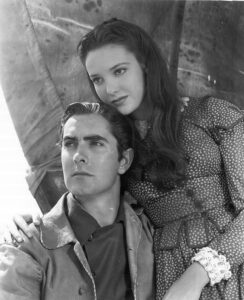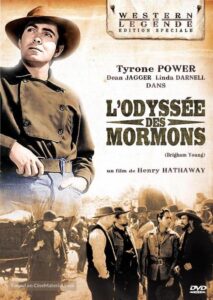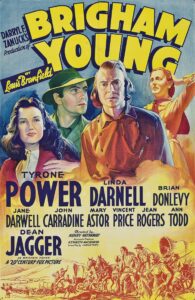I watched the 1940 film Brigham Young produced by 20th Century Fox recently and was caught off-guard by its refreshingly sympathetic treatment of the early Mormon experience.
Featuring Dean Jagger (who later became a baptized member) as Brigham Young and Vincent Price as Joseph Smith, the plot spans from the persecutions leading up to Smith’s martyrdom at the hands of a violent mob to the eventual exodus and arrival of tens of thousands of Mormon pioneers to the Salt Lake Valley, under the leadership of Brigham Young.
A few things in particular struck me:
1) The film is essentially Hollywood’s first large scale depiction of Mormon history, being released after years of Silent Era exploitative pictures which depicted Latter-day Saints as little more than barbaric human traffickers and criminals. It bore the challenge of compactly establishing the basic driving factors for how the Saints ended up in Utah to a mainstream (and hardly sympathetic) national audience, electing to frame the Mormon experience within the lens of religious freedom and collective security.
2) Its framing and release in 1940 was an intentional commentary on the contemporary and worsening systematic persecutions of the Jews in Germany/Europe. Indeed, the horror of Kristallnacht had occurred just two years previously, with the producers of the film similarly referring to the Mormon sufferings as “pogroms.” Should this feel excessive to anyone, Raphael Lemkin, who coined the term “genocide,” was of the view that the Mormon experience in Missouri qualified.
 3) On a smaller front, the script features a reference to how Mormons were considered outside the bounds of “Whiteness” at the time. Brigham Young is humanized by repeatedly questioning the reality of his own prophetic calling. Several passing and direct references to polygamy are made, including a more extended exchange depicting its rightful difficulty as a subject, especially for women.
3) On a smaller front, the script features a reference to how Mormons were considered outside the bounds of “Whiteness” at the time. Brigham Young is humanized by repeatedly questioning the reality of his own prophetic calling. Several passing and direct references to polygamy are made, including a more extended exchange depicting its rightful difficulty as a subject, especially for women.
4) While not produced by the LDS Church, its depiction would likely be considered fairly hagiographic by today’s historical standards. Juxtaposed against what typically passes for a “nuanced and humanizing” (I say that with at least a small degree of eyeroll) account of Mormonism in the popular image and again, it was a refreshing departure — although a bloodthirsty, tyrannical, and warmongering Young surely isn’t far off in the forthcoming Netflix show, “American Primeval.”
 I suppose part of what was “refreshing” in this respect was not feeling overly “preached” to with the claimed “important conversations” that contemporary Hollywood feels the need to lecture Latter-day Saints on regarding the ills and harms internal to their own tradition and community—and rarely from the positionality of practicing, invested believers.
I suppose part of what was “refreshing” in this respect was not feeling overly “preached” to with the claimed “important conversations” that contemporary Hollywood feels the need to lecture Latter-day Saints on regarding the ills and harms internal to their own tradition and community—and rarely from the positionality of practicing, invested believers.
To be clear, I’m not saying that former members of the faith have no place at the table of conversation on critical Mormon topics. If we altogether ignore their contributions, current members risk their own form of media blindness as well. My point is more that it can seem an all-too-convenient marriage of forces when a largely conservative-faith allergic Hollywood happily platforms those with the reductive and jaded outlook that Mormon media depictions must devolve into either comedy or horror.
Jaxon Washburn is a doctoral student at the University of California – Los Angeles’ Near Eastern Languages & Cultures department, specializing in Armenian studies. Outside of his emphasis, he also writes broadly on Mormonism, interfaith topics, and the study of religion.


Love the French DVD cover! 😀